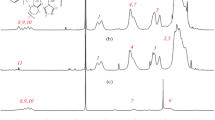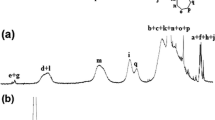Abstract
Five CTA’s xanthate-type were synthesized and characterized and used in the controlled polymerization of N-vinylcaprolactam (NVCL) via reversible addition-fragmentation chain transfer (RAFT) polymerization. The CTA’s are linear (bifunctional), with three arms (from cholic acid or trimethylolpropane tris[poly(propylene glycol), amine terminated] ether), with six arms (from DPERT) and nine arms (from glycerol functionalized with cholic acid). Three of the synthesized CTA’s are reported for the first time. The intrinsic viscosity [η] and the Mark-Houwink-Kuhn-Sakurada (MHKS) constants were estimated in ethanol at 35 °C for each PNVCL polymer group. The η values for star-shaped polymers were lower compared with the linear analogues with similar molecular weights. Interestingly, the intrinsic viscosity values of two groups of polymers having three arms shown a noticeable difference, probably due to starting material used to prepare the CTA (rigid or flexible core). The MHKS exponents ranged from 0.68 to 0.82 indicates that all polymers behave as a flexible expanded conformation. The hydrodynamic diameter (Dh) of the polymers in ethanol solution was measured using DLS. The Dh values decreased significantly with the molecular weight (Mn) decreasing. The Dh values of linear polymers were higher compared with the stars one with similar molecular weights. Star-shaped PNVCL polymers containing cholane skeleton shown remarkable lower viscosity values.








Similar content being viewed by others
References
Deng Y, Zhang S, Lu G, Huang X (2013) Constructing well-defined star graft copolymers. Polym Chem 4:1289–1299
Flory PJ, Fox TG (1951) Treatment of intrinsic viscosities. J Am Chem Soc 73:1904–1908
Lu Y, An L, Wang ZG (2013) Intrinsic viscosity of polymers: general theory based on a partially permeable sphere model. Macromolecules 46:5731–5740
Mendrek B, Trzebicka B, Walach W, Dworak A (2010) Solution behavior of 4-arm poly(tert-butyl acrylate) star polymers. Eur Polym J 46:2341–2351
Anilkumar P, Lawson TB, Abbina S, Mäkelä JT, Sabatelle RC, Takeuchi LE, Snyder BD, Grinstaff MW, Kizhakkedathu JN (2020) Mega macromolecules as single molecule lubricants for hard and soft surfaces. Nat Commun 11:2139
Khabaz F, Khare R (2014) Effect of chain architecture on the size, shape, and intrinsic viscosity of chains in polymer solutions: a molecular simulation study. J Chem Phys 141:214904–214910
Shang Y, Zheng N, Wang Z (2019) Tetraphenylsilane-cored star-shaped polymer micelles with pH/redox dual response and active targeting function for drug-controlled release. Biomacromolecules 20:4602–4610
Chen YF, Lai YD, Chang CH, Tsai YC, Tang CC, Jan JS (2019) Star-shaped polypeptides exhibit potent antibacterial activities. Nanoscale 11:11696–11708
Pan Y, Cai P, Farahani M, Li Y, Hou X, Xiao H (2016) Amino-functionalized alkaline clay with cationic star-shaped polymer as adsorbents for removal of Cr(VI) in aqueous solution. Appl Surf Sci 385:333–340
Cosimbescu L, Robinson JW, Zhou Y, Qu J (2016) Dual functional star polymers for lubricants. RSC Adv 6:86259–86268
Boschmann D, Vana P (2005) Poly(vinyl acetate) and poly(vinyl propionate) star polymers via reversible addition fragmentation chain transfer (RAFT) polymerization. Polym Bull 53:231–242
Herberg A, Yu X, Kuckling D (2019) End group stability of atom transfer radical polymerization (ATRP)-synthesized poly(N-isopropylacrylamide): perspectives for Diblock copolymer synthesis. Polymers 11:678
Tan H, Zhang G, Lin Y, Ma L, Tang T (2016) Synthesis of polystyrene-based Y-shaped asymmetric star by the combination of ATRP/RAFT and its thermal and rheological properties. RSC Adv 6:106648–106655
Hansen KA, Blinco JP (2018) Nitroxide radical polymers – a versatile material class for high-tech applications. Polym Chem 9:1479–1516
Cortez-Lemus NA, Licea-Claverie A (2016) Poly(N-vinylcaprolactam), a comprehensive review on a thermoresponsive polymer becoming popular. Prog Polym Sci 53:1–51
Wu Q, Yi J, Yin Z, Wang S, Yang Q, Wu S, Song X, Zhang G (2013) Synthesis and self-assembly of new amphiphilic thermosensitive poly(N-vinylcaprolactam)/poly(ε-caprolactone) block copolymers via the combination of ring-opening polymerization and click chemistry. J Polym Res 262:1–9
García-Olaiz GD, Montoya-Villegas KA, Licea-Claverie A, Cortez-Lemus NA (2015) Synthesis and characterization of four- and six-arm star-shaped poly(ε-caprolactone)-b-poly(N-vinylcaprolactam): Micellar and core degradation studies. React Funct Polym 88:16–23
Wan D, Zhou Q, Pu H, Yang G (2008) Controlled radical polymerization of N-vinylcaprolactam mediated by Xanthate or Dithiocarbamate. J Polym Sci Part A Polym Chem 46:3756–3765
Castro Hernández AA, Cortez Lemus NA (2019) Thermo/pH responsive star and linear copolymers containing a Cholic acid-derived monomer, N-Isopropylacrylamide and acrylic acid: synthesis and solution properties. Polymers 11:1859
Cunningham AJ, Gibson VP, Banquy X, Zhu XX, Jeanne LC (2020) Cholic acid-based mixed micelles as siRNA delivery agents for gene therapy. Int J Pharm 578:119078
Barner-Kowollik C, Davis TP, Stenzel MH (2006) Synthesis of star polymers using RAFT polymerization: what is possible? Aust J Chem 59:719–727
Cortez-Lemus NA, Licea-Claverie A (2018) Preparation of a Mini-library of thermo-responsive star (NVCL/NVP-VAc) polymers with tailored properties using a Hexafunctional Xanthate RAFT agent. Polymers 10:20
Li L, Lu Y, An L, Wu C (2013) Experimental and theoretical studies of scaling of sizes and intrinsic viscosity of hyperbranched chains in good solvents. J Chem Phys 138:114908
Sakai T (1968) Huggins constant k’ for flexible chain polymers. J Polym Sci A2 6:1535–1549
Riseman J, Ullman R (1951) The concentration dependence of the viscosity of solutions of macromolecules. J Chem Phys 19:578–584
Urinov E, Kirgizbayeva M, Kosimov AS, Rashidova SS (1989) Some conformational parameters of poly(vinylpyrrolidone), poly(vinylcaprolactam) and their copolymers in dilute solutions. Polym Sci USSR 31:666–672
Zou T, Cheng SX, Zhang XZ, Zhuo RX (2007) Novel cholic acid functionalized star oligo/poly(DL-lactide)s for biomedical applications. J Biomed Mater Res Part B Appl Biomater 82B:400–407
Donvito A, Fantin G, Fogagnolo M, Giovannini PP, Scoponi M (2016) Novel tri- and tetrafunctional cholic acid-based initiators for the synthesis of star-shaped poly(L-lactide)s. Des Monomers Polym 19:535–544
Acknowledgements
This investigation was supported by the National Council of Science and Technology of México (CONACYT) through grant SEP-CONACYT (CB-2014-01-237795). We kindly appreciate the support of Dr. V. Miranda for their technical support in the NMR analysis.
Author information
Authors and Affiliations
Corresponding author
Ethics declarations
Conflict of interest
The authors declare no conflict of interest.
Additional information
Publisher’s note
Springer Nature remains neutral with regard to jurisdictional claims in published maps and institutional affiliations.
Rights and permissions
About this article
Cite this article
Cortez-Lemus, N.A., Castro-Hernández, A. Intrinsic viscosity of poly(N-vinylcaprolactam) with varying the architecture. J Polym Res 27, 225 (2020). https://doi.org/10.1007/s10965-020-02220-3
Received:
Accepted:
Published:
DOI: https://doi.org/10.1007/s10965-020-02220-3




